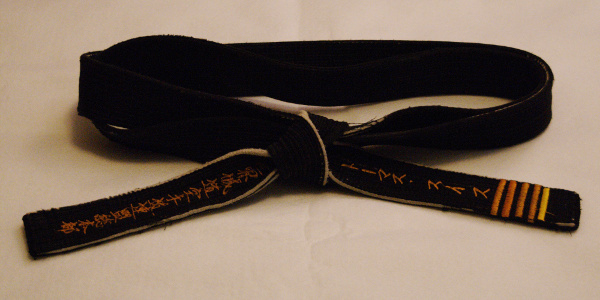
I spent this past weekend in New York, at the headquarters dojo (Honbu) of the World Seido Karate Organization. Dozens of students were testing for black belt levels, and I was there to support my fellow students from Maryland and to help out a little with the testing. That included getting up at 5am to help with the sparring Sunday morning. There are very few things in this world for which I will wake up at 5am on a Sunday, but getting to be part of the story of someone's black belt test is one of them.
There are easier ways to get a black belt than to travel to another city, subject yourself to the scrutiny of a master teacher you've never met before, and endure the punches and kicks of experts. You can find ads in the martial arts magazines for the martial arts equivalent of diploma mills, who will charge you a fee to "evaluate" your training and send you a belt and a certificate. You even can go to karatedepot.com and buy a black belt for under five dollars. But this would be obtaining the symbol without the meaning.
There are a lot of stories about the origin of the black belt -- for example, one says that in the old days the obi of a budoka progressively got dirtier and stained itself over time from white to green to brown to black. But as far as I can tell the facts are more mundane: as Jigoro Kano was developing judo out of its roots in ju-jitsu in the 1880s, he gave his senior students black sashes to wear with their kimono -- which was their ordinary clothing at that time. It was many years after that that he developed the judogi and the modern rank belt. The dogi and obi then came to karate as that art was introduced to "mainland" Japan from Okinawa. (The term "obi" can refer to either a traditional kimono sash or to a modern martial arts belt.)
Those who don't train or are new to the martial arts often think of a black belt as denoting mastery. But really it means only a competence in the basics. We call the first black belt rank "shodan", which means "beginner's rank." (The "sho" here is the same as "shoshin", "beginner's mind/heart".) It's an important milestone but traditional martial arts are a lifetime pursuit and one does not master them in the handful of years it takes to earn shodan ranking.
However, with that said, in many schools (including Seido) reaching black belt is in effect a sort of initiation, in the ritual sense of the term. It's not just a matter of demonstrating competence but about going through a deep experience which changes a person. The traditional martial arts have many aspects of ritual about them: special garb, special words and gestures ("osu", bowing, sitting seiza), a delineated "sacred space". All of these elements contribute and focus mental energy -- they energize and excite us.
When we add to them the physical energy of intense training, we have the possibility for something very special, something transformative, to happen.
And that's something that I hope you get to experience at each promotion, whether it's your blue belt promotion or your godan. Each should help you become more your best self.